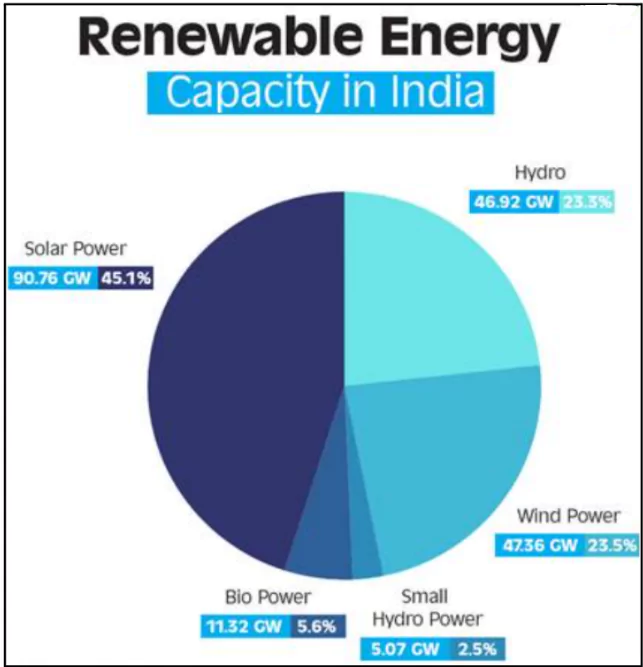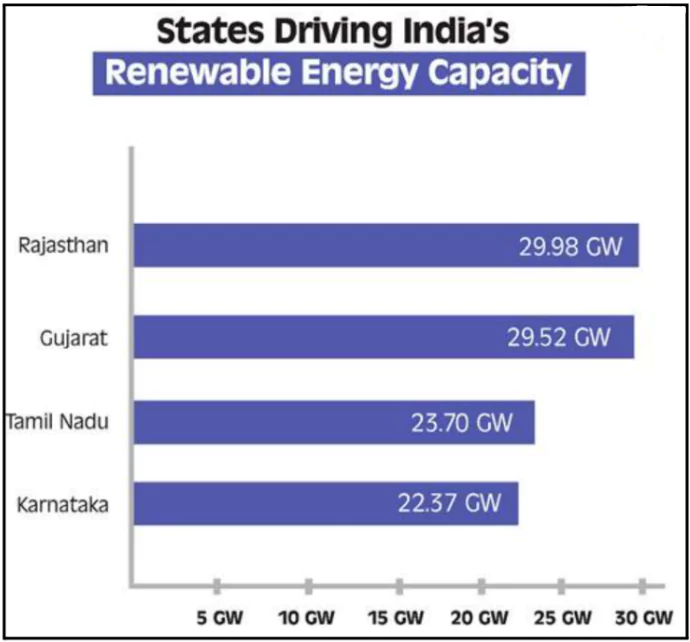India has crossed a significant milestone in its renewable energy journey, with total renewable energy capacity exceeding 200 GW as of October 10, 2024.

- According to the Central Electricity Authority, the total renewable energy-based electricity generation capacity now stands at 201.45 GW.
India’s Renewable Energy Share Rises to 46.3% of Total Capacity
- Increased Share in total Energy: Renewable energy now constitutes 46.3% of the country’s total electricity generation capacity, marking a major shift in India’s energy landscape.
- Renewable Energy Landscape in India: As of October 2024, India’s total electricity generation capacity stands at 452.69 GW, with renewable energy accounting for 201.45 GW of that capacity.
Enroll now for UPSC Online Course
Role of Government
- Government Schemes and Programmes: India’s push towards renewable energy is supported by various government initiatives as shown in the Table.
| Scheme/Programme |
Key Provisions |
| National Green Hydrogen Mission |
- Aims to produce 5 million tonnes of green hydrogen annually by 2030.
- Promotes development of green hydrogen production, storage, and export facilities.
|
| PM-KUSUM Scheme |
- Aims to install solar pumps and grid-connected solar power plants in rural areas.
- Provides subsidies for farmers to install solar irrigation pumps.
|
| PLI Schemes for Solar PV Modules |
- – Offers incentives for manufacturing high-efficiency solar PV modules in India.
- – Encourages domestic production to reduce dependence on imports.
|
| Waiver of Inter-State Transmission System Charges |
- Waives transmission charges for solar and wind projects commissioned by June 2025.
- Green hydrogen projects are exempt from transmission charges until December 2030.
|
| Ultra Mega Renewable Energy Parks |
- Establishes large-scale renewable energy parks to provide land and transmission for solar and wind projects.
- Attracts investment and accelerates project development.
|
| National Repowering and Life Extension Policy |
- Focuses on repowering older wind power projects to enhance their efficiency.
- Aims to increase the capacity and output of aging wind turbines.
|
| Strategy for Establishment of Offshore Wind Projects |
- Aims to set up 37 GW of offshore wind energy by 2030.
- Provides a clear roadmap for development and deployment of offshore wind energy projects, including regulatory and investment frameworks.
|
- The government has also introduced several policy measures to promote renewable energy:
- Renewable Purchase Obligation (RPO) and Energy Storage Obligation Trajectory 2029-30.
 Green Energy Open Access Rules 2022, to promote renewable energy.
Green Energy Open Access Rules 2022, to promote renewable energy.- Electricity (Rights of Consumers) Rules, 2020, for net-metering up to 500 kilowatts.
- Green Term Ahead Market (GTAM), to facilitate the sale of renewable energy power through exchanges.
- Leading States in Renewable Energy Capacity: Rajasthan, Gujarat, Tamil Nadu and Karnataka.
- These states play a crucial role in driving India’s renewable energy goals, leveraging favorable geographic conditions for solar and wind energy.
Check Out UPSC CSE Books From PW Store
Significance of the achievement in Renewable Energy
- Sustainable Development Goal 7: Under SDG 7 India aims to ensure access to affordable, reliable, sustainable, and modern energy for all’ by 2030.
- India’s Energy Target: In line with the ambitious target of 500 GW of installed capacity from non-fossil fuel sources by 2030.
- Energy Security: The country’s proactive approach to diversifying energy sources not only enhances energy security but also contributes significantly to mitigating climate change.
![]() 16 Oct 2024
16 Oct 2024

 Green Energy Open Access Rules 2022, to promote renewable energy.
Green Energy Open Access Rules 2022, to promote renewable energy.